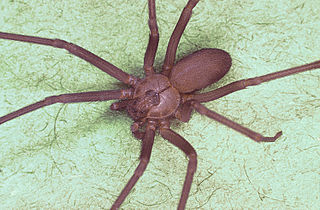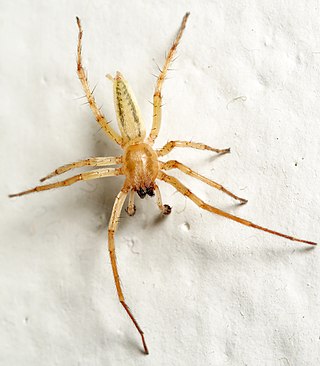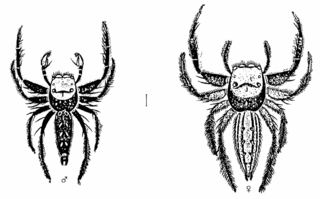
Wolf spiders are members of the family Lycosidae. They are robust and agile hunters with excellent eyesight. They live mostly in solitude, hunt alone, and usually do not spin webs. Some are opportunistic hunters, pouncing upon prey as they find it or chasing it over short distances; others wait for passing prey in or near the mouth of a burrow.

Sicariidae is a family of six-eyed venomous spiders known for their potentially necrotic bites. The family consists of three genera and about 160 species. Well known spiders in this family include the brown recluse spider and the six-eyed sand spider.

Anyphaenidae is a family of araneomorph spiders, sometimes called anyphaenid sac spiders. They are distinguished from the sac spiders of the family Clubionidae and other spiders by having the abdominal spiracle placed one third to one half of the way anterior to the spinnerets toward the epigastric furrow on the underside of the abdomen. In most spiders the spiracle is just anterior to the spinnerets. Like clubionids, anyphaenids have eight eyes arranged in two rows, conical anterior spinnerets and are wandering predators that build silken retreats, or sacs, usually on plant terminals, between leaves, under bark or under rocks. There are more than 600 species in over 50 genera worldwide.

Agobardus is a genus of jumping spiders that was first described by Eugen von Keyserling in 1885.

Bavia is a genus of jumping spiders.

Prostheclina is a genus of Australian jumping spiders that was first described by Eugen von Keyserling in 1882.

Saitis is a genus of jumping spiders that was first described by Eugène Louis Simon in 1876. The Australian species may belong to other genera, such as Maratus.
Salpesia is a genus of jumping spiders that was first described by Eugène Louis Simon in 1901.

Sandalodes is a genus of jumping spiders that was first described by Eugen von Keyserling in 1883. S. scopifer, a black spider with white markings, is a common species in eucalypt forests on the Darling Downs.

Ordgarius is a genus of orb-weaver spiders first described by Eugen von Keyserling in 1886. Adult females of the genus are bolas spiders, capturing their prey with one or more sticky drops at the end of a single line of silk rather than in a web. Males and juvenile females capture their prey directly with their legs.

The spider species Plebs eburnus is commonly referred to as the eastern grass orb-weaver or the eastern bush orb-weaver, and sometimes more simply as the bush orb-weaver. It is an orb-weaver spider from the family Araneidae endemic to Australia. It is a very common spider with distinctive white markings, which give it the species name eburnus pertaining to ivory. It is found in scrub and tall grasses where the female constructs a vertical web usually no more than 2 metres from the ground, and stays there day and night. The web of some of these spiders has been seen to be decorated with nearly vertical stabilimentum. The stabilimentum of the related P.cyphoxis is usually observed vertical.

Sidymella is a genus of spider in the family Thomisidae, found in South America, Australia and New Zealand. It was originally named Sidyma, but this was later found to have been used already for a genus of moths.
Epeiroides is a genus of orb-weaver spiders containing the single species, Epeiroides bahiensis. It was first described by Eugen von Keyserling in 1885, and has only been found in Costa Rica and Brazil.
Eilica is a genus of ground spiders that was first described by Eugen von Keyserling in 1891.
Gmogala is a monotypic genus of South Pacific comb-footed spiders containing the single species, Gmogala scarabaeus. It was first described by Eugen von Keyserling in 1890, and is found in Australia and Papua New Guinea.

Zenodorus orbiculatus, the round ant eater, is a species of ant-hunting jumping spider found in Australia. The species was first formally named by Eugen von Keyserling in 1881 as Hasarius orbiculatus.
Isometroides is a genus of scorpions in the Buthidae family with two species. It is endemic to, and found widely across, inland mainland Australia, and was first described by German arachnologist Eugen von Keyserling in 1885.
Isometroides vescus, also known as the spider-hunting scorpion or spiral burrow scorpion, is a species of scorpion in the Buthidae family. It is native to Australia, and was first described by German arachnologist Ferdinand Karsch in 1880.

Urodacus novaehollandiae, also known as the coastal burrowing scorpion or black sand scorpion, is a species of scorpion in the Urodacidae family. It is endemic to Australia, and was first described in 1861 by German naturaliat Wilhelm Peters.












